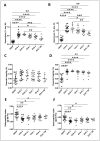The purified vepoloxamer prevents haemolysis in 42-day stored, DEHP/PVC-free red blood cell units
- PMID: 28263175
- PMCID: PMC5336339
- DOI: 10.2450/2017.0351-16
The purified vepoloxamer prevents haemolysis in 42-day stored, DEHP/PVC-free red blood cell units
Abstract
Background: Use of the plasticiser di(2-ethylhexyl) phthalate (DEHP) in polyvinyl chloride (PVC) blood bags poses a potential dilemma. The presence of DEHP in blood bags has been shown to be beneficial to red blood cells during storage by diminishing haemolysis. However, DEHP use in PVC may be carcinogenic or estrogenising. Vepoloxamer is a poloxamer with rheological and cytoprotective rheological properties and a favourable toxicity profile in clinical trials. We hypothesised that vepoloxamer may be sufficient to replace the plasticiser DEHP to prevent elevated haemolysis while conserving the biochemical and redox potential++ in RBCs stored for up to 42 days.
Materials and methods: Paired analyses of aliquots from pooled RBC suspensions of ABO identical donors were aseptically split into test storage containers (DEHP/PVC or DEHP-free/ethylene vinyl acetate [EVA]) supplemented with or without vepoloxamer (at concentrations of 0.1, 1, 5 or 7.89 mg/mL) and cold stored for up to 42 days.
Results: Vepoloxamer significantly prevented the increased haemolysis induced by the absence of DEHP in EVA bags in a dose-dependent manner by days 28 and 42 of storage (approx. 50% reduction of the maximum concentration of vepoloxamer; p<0.001). There was an inverse correlation between the concentration of vepoloxamer used and the haemolysis rate (r2=0.27, p<0.001) and a direct correlation between haemolysis and phosphatidylserine (PS) exposure (r2=0.42; p<0.01). Increased osmotic fragility and shear induced deformability of 42-day stored RBC in EVA bags was significantly corrected by the addition of vepoloxamer.
Discussion: Vepoloxamer, in a concentration-dependent fashion, is able to partly rescue the increased haemolysis and PS exposure induced by the absence of the commonly used plasticiser DEHP. These results provide initial but strong evidence to support vepoloxamer use to replace DEHP in long-term storage of RBC.
Conflict of interest statement
RME and DSMc-K are employees of Mast Therapeutics Inc. Mast Therapeutics Inc. provided study materials and funds to conduct this study. The other Authors declare no conflicts of interest.
Figures



Similar articles
-
Exploratory in vitro study of red blood cell storage containers formulated with an alternative plasticizer.Transfusion. 2012 Jul;52(7):1439-45. doi: 10.1111/j.1537-2995.2011.03506.x. Epub 2011 Dec 30. Transfusion. 2012. PMID: 22211692
-
An investigation of red blood cell concentrate quality during storage in paediatric-sized polyvinylchloride bags plasticized with alternatives to di-2-ethylhexyl phthalate (DEHP).Vox Sang. 2016 Apr;110(3):227-35. doi: 10.1111/vox.12355. Epub 2015 Dec 8. Vox Sang. 2016. PMID: 26646434
-
Non-phthalate plasticizer DEHT preserves adequate blood component quality during storage in PVC blood bags.Vox Sang. 2021 Jan;116(1):60-70. doi: 10.1111/vox.12982. Epub 2020 Sep 12. Vox Sang. 2021. PMID: 32918773
-
Commercially available blood storage containers.Vox Sang. 2014 Jan;106(1):1-13. doi: 10.1111/vox.12084. Epub 2013 Sep 16. Vox Sang. 2014. PMID: 24102543 Review.
-
Progress in the removal of di-[2-ethylhexyl]-phthalate as plasticizer in blood bags.Transfus Med Rev. 2012 Jan;26(1):27-37. doi: 10.1016/j.tmrv.2011.06.001. Epub 2011 Aug 5. Transfus Med Rev. 2012. PMID: 21820855 Review.
Cited by
-
Concurrent Assessment of Deformability and Adhesiveness of Sickle Red Blood Cells by Measuring Perfusion of an Adhesive Artificial Microvascular Network.Front Physiol. 2021 Apr 28;12:633080. doi: 10.3389/fphys.2021.633080. eCollection 2021. Front Physiol. 2021. PMID: 33995119 Free PMC article.
-
Vepoloxamer improves functional recovery in rat after traumatic brain injury: A dose-response and therapeutic window study.Neurochem Int. 2024 Feb;173:105659. doi: 10.1016/j.neuint.2023.105659. Epub 2023 Dec 22. Neurochem Int. 2024. PMID: 38142856 Free PMC article.
References
-
- Heudorf U, Mersch-Sundermann V, Angerer J. Phthalates: toxicology and exposure. Int J Hyg Environ Health. 2007;210:623–34. - PubMed
-
- Scientific Committee on Emerging and Newly-Identified Health Risks. Preliminary report on the safety of medical devices containing DEHP-plasticized PVC or other plasticizers on neonates and other groups possibly at risk. Health & Consumer Protection, European Commission; 2007. [Accessed on 17/01/2017]. Available at: http://ec.europa.eu/health/ph_risk/committees/04_scenihr/docs/scenihr_o_.... - PubMed
-
- Food and Drug Administration, Health CfDaR. Safety assessment of di(2-ethylhexyl)phthalate (DEHP) released from PVC medical devices. 2002. [Accessed on 17/01/2017]. Available at: DeviceRegulationandGuidance/GuidanceDocuments/UCM080457.pdf.
-
- Jaeger RJ, Rubin RJ. Plasticizers from plastic devices extraction, metabolism, and accumulation by biological systems. Science. 1970;170:460–2. - PubMed
MeSH terms
Substances
LinkOut - more resources
Full Text Sources
Other Literature Sources
